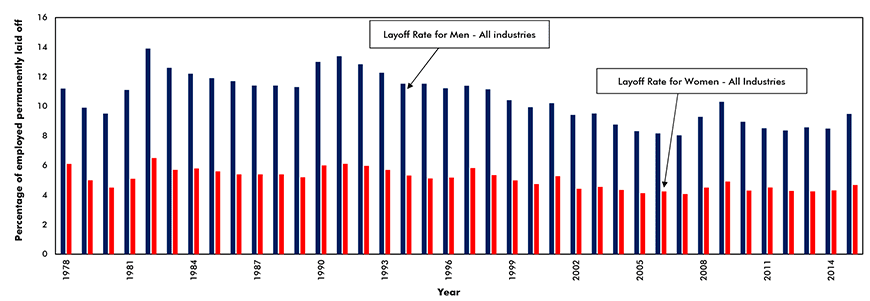The tsunami-like impact of COVID-19 on the Canadian labour market has caused many to focus on the roughly 2.5 million workers temporarily laid off in March and April of this year and overlook the 6.8 million mostly full-time jobs the economy has added since the early 1980s. A recent study of job displacement and job types by Statistics Canada analyzed the pattern of permanent layoffs between 1976 and 2016 (the most recent data available) and puts some perspective on the temporary layoffs caused by COVID-19. A ‘permanent layoff’ occurs when a laid-of worker does not return to their employer for at least a year.
Pre-COVID, permanent layoff rates were trending lower despite increased outsourcing
The attention-grabbing finding of the Statistics Canada study, titled Permanent Layoff Rates in Canada 1978 to 2016, is that “there is little evidence that the extent of job displacement or its financial consequences for permanently laid-off workers have worsened over the past thirty-eight years despite the significant increase in globalization, the rapid adoption of new labour-saving technology and the fact that the percentage of the workforce in the manufacturing industry has shrunk from 19% to 9% since 1976.”
Permanent layoff rates in service-producing industries lower than in goods production
The chart highlights that the layoff rate for males is, on average, twice that of females largely due to the higher percentage of men employed in more cyclically sensitive goods-producing industries (78%), specifically manufacturing (40%). The majority (90%) of females work in services-producing industries such as health care (22%), education (11%), and wholesale and retail trade (15%), which (until COVID) have been less sensitive to fluctuations in the business cycle.
Mass layoffs account for less than 15% of permanent layoffs
Few pay attention when a firm lays off a small number of workers. Mass layoffs, on the other hand, such as the closing of the GM plant in Oshawa or the Heinz plant in Leamington, which involve more than 50 employees, seem to attract a disproportion amount of publicity given that between 1995 and 2015, mass layoffs accounted, on average, for just 13% of all layoffs. According to the study, the majority (52%) of all layoffs occur in firms with under 50 employees, while larger firms with more than 50 employees account for approximately 35%.
Project-linked jobs boost construction industry’s layoff rate
Over the past four decades, layoff rates for males in the construction industry have averaged 40%, which is several orders of magnitude higher than the all-industry average of 10%. This difference stems from more construction workers being hired to work on a project basis for a specified period of time. Further, while employment in the construction industry has increased twice as fast as the rest of the economy, the layoff rate in the industry has trended sharply lower, from 59.1% to 31.4%, over the past 24 years.
Pre-COVID, re-employment of laid-off workers accelerates 2010 to 2015
Anybody who watches the news knows that there is still a very thick cloud of uncertainty hanging over the employment outlook in the post-COVID world. However, the pattern of re-employment rates of permanently laid off workers over the past several years may shed some light on what is in store for the 2.5 million workers temporarily laid off since mid-March due to COVID-19. While, as noted above, layoff rates for both sexes have trended lower over the past four decades, women have had better luck getting back into the labour force than men. In 1976, 67% of permanently laid-off women were re-employed within a year. However, by 2015, 78% of them had found a new situation. Over the same interval, the post layoff job prospects for male workers have remained essentially unchanged.
The hiring outlook – especially in construction – appears brighter
What does the future hold for employment in general and for construction in particular? Turning first to the near-term outlook, several indicators of both hiring and building intentions are showing signs of improvement. Following the solid gain in May hiring, the Ivey Employment Index, the Conference Board’s Index of Consumer Confidence employment series and the Canadian Federation of Independent Business’ hiring plans index all signalled the very strong almost one-million-jobs gain in June hiring. Further, after posting solid gains of +73,000 jobs in May and +83,000 in June, the hiring prospects in construction remain positive in the wake of the 20% jump in May building permits that was driven by strong increases in both residential and non-residential building intentions, largely concentrated in Quebec, Ontario, B.C. and P.E.I.
In the second half of this year, the effects of the COVID-19 induced drop in immigration and a concomitant reduction in labour force participation of older more vulnerable workers should encourage more employers to hire from the pool of temporarily laid-off younger workers, thereby preventing them from being classified as ‘permanently laid-off’.
John Clinkard has over 35 years’ experience as an economist in international, national and regional research and analysis with leading financial institutions and media outlets in Canada.
Layoff Rates* for Males and Females – 1978 to 2015

Chart: ConstructConnect — CanaData.











Recent Comments
comments for this post are closed